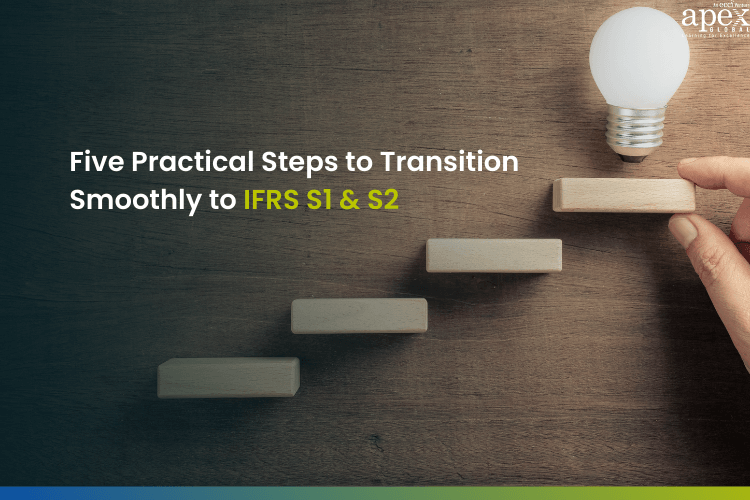The transition towards reporting with a sustainability focus has moved into a critical phase with the issuance of IFRS S1 and IFRS S2 standards by the International Sustainability Standards Board (ISSB). The standards are aimed at enhancing the quality, transparency, and comparability of disclosures relating to sustainability across the globe, arming investors and stakeholders with information on which they can make sound decisions.
For companies, however, the move to these frameworks is not just a compliance process, it is a chance to integrate sustainability into the core of business strategy. The switch can seem daunting at the outset, with the extent of disclosure and the requirement for congruence with current practice, but with careful steps, organisations can get ready not only for compliance but for sustained value creation.
Following are five steps of practical action to facilitate smooth transition to IFRS S1 and S2 for companies.
What you'll find in this article
- 0.1 Step 1: Understand the Requirements in Depth
- 0.2 Step 2: Identify Gaps in Current Practices
- 0.3 Step 3: Establish Short- and Long-Term Actions
- 0.4 Step 4: Mainstream Climate Action and Disclosure
- 0.5 Step 5: Embed Sustainability into Governance and Risk Management
- 1 Why These Steps Matter
- 2 Conclusion
Step 1: Understand the Requirements in Depth
The first step towards a successful transition is to build a thorough understanding of IFRS S1 and S2. Both standards provide detailed guidance on what organisations need to disclose and how disclosures should be presented.
- IFRS S1 sets out the general requirements for sustainability-related disclosures. It focuses on material impacts, risks, and opportunities that could influence enterprise value, and provides a structure to ensure consistency across different markets and industries.
- IFRS S2 is dedicated to climate-related disclosures. It is closely aligned with the Task Force on Climate-related Financial Disclosures (TCFD) recommendations and requires companies to disclose governance, strategy, risk management, and metrics related to climate change.
For leadership teams, sustainability officers, and finance professionals, it is crucial to familiarise themselves with both the scope and structure of these standards. Internal workshops, knowledge-sharing sessions, and cross-functional discussions can be useful for building awareness. These activities ensure that the technical aspects of the standards are clearly understood and that buy-in is secured across the organisation. Without this foundational step, companies risk misinterpreting requirements or treating compliance as a box-ticking exercise rather than a strategic opportunity.
Step 2: Identify Gaps in Current Practices
Most organisations already engage in some form of sustainability or ESG reporting, whether through integrated reports, Global Reporting Initiative (GRI) frameworks, or TCFD-aligned disclosures. However, these efforts may not fully meet the requirements of IFRS S1 and S2. This is why conducting a gap analysis is a critical next step.
A gap analysis involves mapping existing reporting practices against the requirements of the new standards. Through this exercise, organisations can identify:
- Areas where they are already aligned, such as climate-related disclosures under TCFD.
- Areas requiring improvement, including forward-looking scenario analysis or metrics for non-climate sustainability risks.
- Data sources that are reliable versus those that need refinement or new collection processes.
This analysis helps prevent duplication of effort and ensures that current practices are integrated into the IFRS framework. Instead of starting from scratch, organisations can build on what already exists. By identifying gaps early, companies can allocate resources more effectively and develop a targeted roadmap for compliance and improvement.
Step 3: Establish Short- and Long-Term Actions
Once gaps are identified, organisations must establish both immediate and long-term actions to address them. This stage is where planning becomes critical. A well-structured action plan ensures that the transition is manageable, systematic, and aligned with business priorities.
Short-term actions may include:
- Strengthening existing data collection processes.
- Assigning clear responsibilities for sustainability data ownership.
- Addressing immediate disclosure gaps, such as climate governance or risk management structures.
Long-term actions, on the other hand, involve broader capacity building and system integration:
- Investing in technology solutions to automate and streamline reporting processes.
- Training teams across sustainability, finance, and governance functions to understand the nuances of IFRS standards.
- Developing robust assurance mechanisms to ensure data reliability.
- Engaging external consultants or trainers for readiness assessments and independent assurance.
By combining short-term and long-term measures, organisations can build momentum while laying the foundation for sustainable, credible reporting practices.
Step 4: Mainstream Climate Action and Disclosure
One of the defining features of IFRS S2 is its strong emphasis on climate-related disclosures. Organisations must demonstrate how they are addressing climate risks and opportunities in a structured and transparent manner. This requires more than reporting—it demands integration of climate considerations into everyday business planning and decision-making.
To meet these requirements, companies should:
- Assess material climate-related risks and opportunities specific to their sector and operations.
- Use scenario analysis to evaluate the potential impacts of climate change on their business models.
- Set measurable climate-related targets, such as carbon reduction goals, and regularly report on progress.
- Integrate climate considerations into investment and capital allocation decisions.
Mainstreaming climate action ensures that reporting is not an isolated exercise but a reflection of the company’s real-world strategy. For Filipino companies, where exposure to typhoons, flooding, and rising sea levels is a pressing reality, credible climate-related disclosures are particularly important. They demonstrate resilience, foresight, and responsibility to stakeholders both locally and globally.
Step 5: Embed Sustainability into Governance and Risk Management
The final step is to embed sustainability into the governance and risk management systems of the organisation. This step ensures that sustainability reporting reflects actual business practices rather than parallel processes.
Key actions include:
- Linking sustainability risks and opportunities to board-level oversight and decision-making.
- Incorporating sustainability into enterprise risk management systems.
- Aligning executive incentives with sustainability performance.
- Ensuring that sustainability goals are integrated into long-term strategic plans.
By embedding sustainability into governance and risk management, organisations demonstrate accountability and long-term resilience. Reporting then becomes a natural extension of business operations, providing stakeholders with confidence in both the organisation’s strategy and its execution.
Why These Steps Matter
The adoption of IFRS S1 and S2 is more than a regulation. It is a sign that more and more people are beginning to recognize that sustainability and climate-related risks have a direct impact on enterprise value. Investors demand greater transparency in order to comprehend risks and opportunities. Regulators are moving towards international standards in order to bring similarity to markets. Leadership in adopting the frameworks earns companies reputational and competitive benefits.
Through these five steps, organisations can move away from a reactive compliance mentality towards an active strategy that enhances trust, resilience, and growth. They not only meet regulators’ requirements but also become credible and forward-looking in the eyes of investors, customers, employees, and communities.
Conclusion
Transitioning to IFRS S1 and S2 may seem challenging, but it is also an opportunity to future-proof your organisation. By understanding requirements, mapping current practices, strengthening data governance, embedding sustainability into strategy, and building capacity, you can achieve a smooth and effective shift.
For professionals and organisations looking to navigate this journey with confidence, structured learning can provide a strong foundation. APEX Global Learning’s course on “Transitioning to IFRS S1 & S2 for Sustainability Reporting” offers the practical tools and expert insights needed to make this transition seamless.

